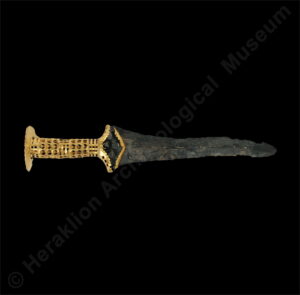
Short sword, usually with a bronze or silver blade and a simple wooden hilt or a more elaborate hilt decorated with precious metals and stones. Daggers were worn in a belt around the waist or a baldric hanging diagonally from the shoulder to the thigh, as we see from male figurines and other pictorial representations. Daggers made of precious materials were not intended for use but were symbols of authority, displaying the prestige and social status of their owners, while some may also have served a ceremonial purpose. Many were produced as votive offerings to sanctuaries. Simple bronze daggers and more elaborate examples were common grave goods in tombs, particularly in the Final Palatial period. The deposition of armour and weapons in tombs is thought to mark the burials of the new Mycenaean aristocracy of Crete, and of the local ruling class that adopted the custom. In Linear B, the word pa-ka-na/phasgana signifies both swords and daggers.